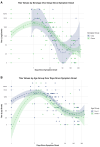Long-term Kinetics of Vibriocidal Antibody Responses After Vibrio cholerae Infection in the Democratic Republic of Congo
- PMID: 40692446
- PMCID: PMC12526859
- DOI: 10.1093/infdis/jiaf382
Long-term Kinetics of Vibriocidal Antibody Responses After Vibrio cholerae Infection in the Democratic Republic of Congo
Abstract
Interpretation of seroepidemiology studies of cholera relies on knowledge of antibody kinetics, which are not well known in African populations. We performed vibriocidal antibody assays on 212 serum samples from 115 patients with culture-positive cholera (median age, 8 years) in Goma, Democratic Republic of Congo, which were collected at enrollment and 3 to 449 days after. Vibriocidal responses peaked at 7 to 40 days after symptom onset, with 89.5% waning to a titer ≤160 by 180 days. We used a bayesian exponential decay model to show an 88% probability of the posterior distribution supporting a faster decay in children ≤5 years of age.
Keywords: antibody kinetics; cholera; seroepidemiology; vibriocidal.
© The Author(s) 2025. Published by Oxford University Press on behalf of Infectious Diseases Society of America.
Conflict of interest statement
Potential conflicts of interest . All authors: No reported conflicts. All authors have submitted the ICMJE Form for Disclosure of Potential Conflicts of Interest. Conflicts that the editors consider relevant to the content of the manuscript have been disclosed.
Figures


Update of
-
Longterm kinetics of vibriocidal antibody responses after V. cholerae infection in the Democratic Republic of Congo.medRxiv [Preprint]. 2025 Apr 11:2025.02.26.25322966. doi: 10.1101/2025.02.26.25322966. medRxiv. 2025. Update in: J Infect Dis. 2025 Oct 15;232(4):e621-e625. doi: 10.1093/infdis/jiaf382. PMID: 40061355 Free PMC article. Updated. Preprint.
References
-
- Kanungo S, Azman AS, Ramamurthy T, Deen J, Dutta S. Cholera. Lancet 2022; 399:1429–40. - PubMed
MeSH terms
Substances
Grants and funding
LinkOut - more resources
Full Text Sources
Medical

